The Calathea Makoyana has some of the most spectacular leaves of any houseplant you’ll find. There’s no wonder it has another name – the Peacock Plant – given how incredible its leaves are.
After all, with markedly striped foliage in varying shades of green, purple and red, this showstopper will look amazing in any room of your house.
Of course, it will only maintain these famed looks with the proper care. Fortunately, the Makoyana certainly isn’t the hardest houseplant in the world to care for, making sure that you’ll be able to get those beautiful leaves to flourish.
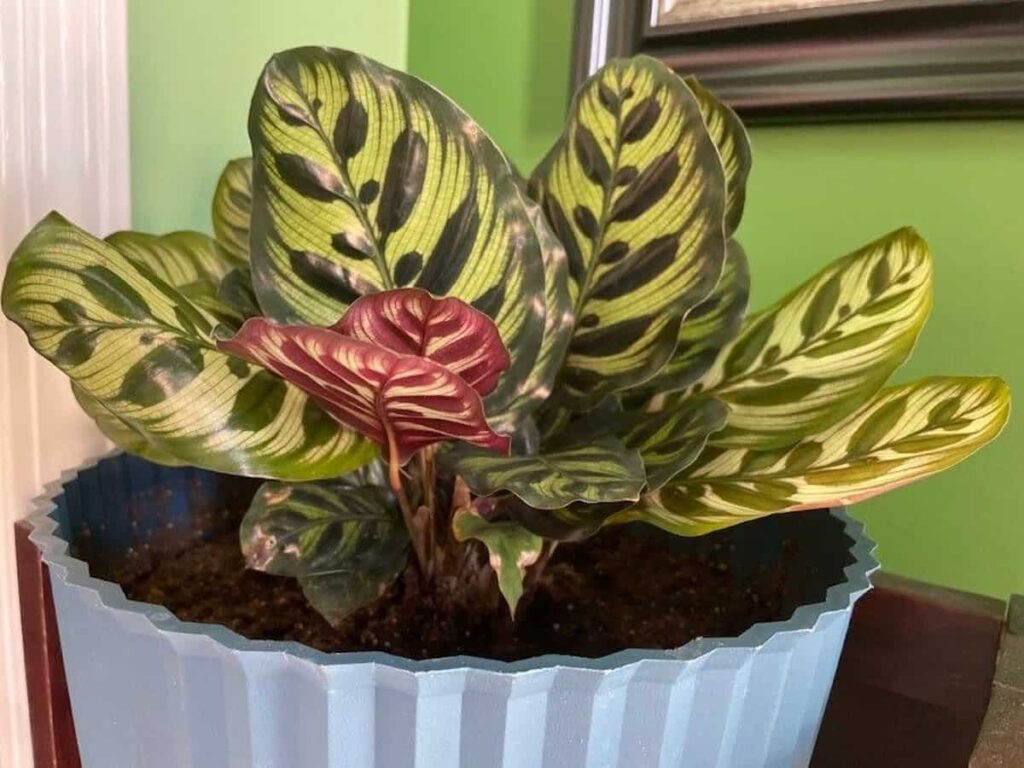
Table of Contents
How do you care for a Calathea Makoyana?
Calathea Makoyana is a high humidity-loving plant that needs constant warm temperatures of between 60 and 75 degrees Fahrenheit. They also need indirect sunlight and like their soil to stay moist but not soggy or overly damp.
Some people say that they can be a bit fiddly to care for but, honestly, there are far more fickle houseplants out there. Just keep an eye on them as you follow each of the steps below, and you should see your Makoyana being happy and healthy.
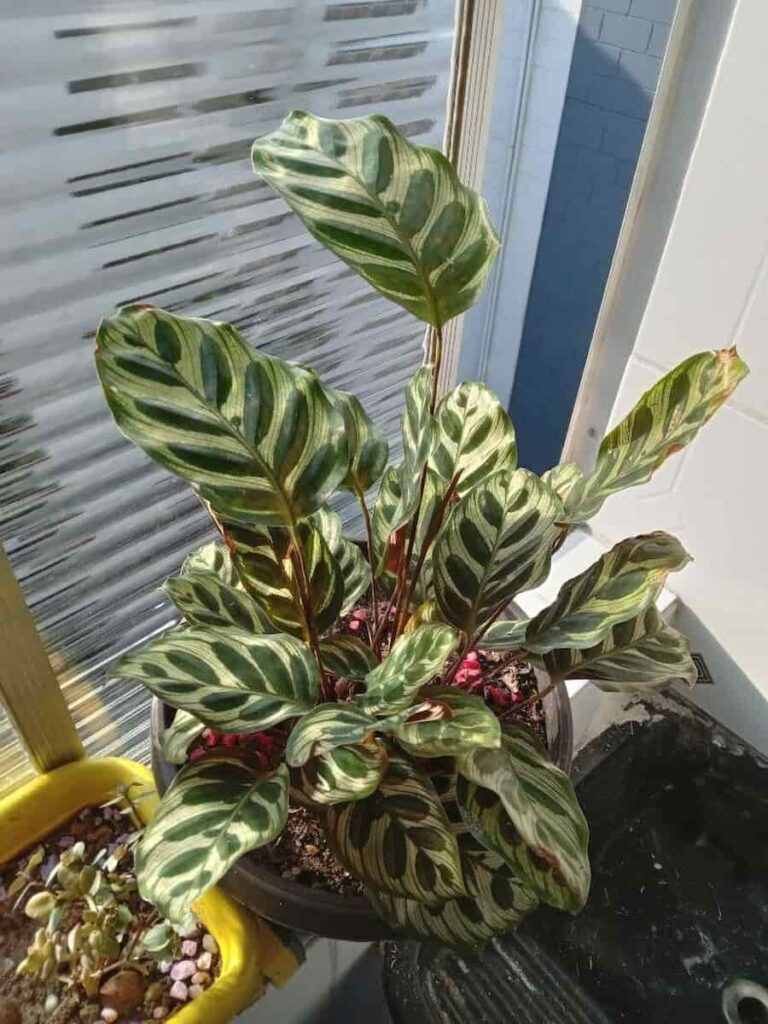
What’s the best Calathea Makoyana soil?
Calathea Makoyana needs soil that holds in moisture while also draining well and allowing the plant’s roots to grow. A good general mixture that works well for this plant is 1 part perlite or coarse sand mixed with 2 parts peat moss.
Alternatively, look for a soil mixture that contains tiny bits of gravel or orchid bark, both of which make the soil more loose and not as compact.
Remember, the best soil mix for Calatheas will retain water while also draining and allowing the plants’ roots to grow and spread. Avoid soil that is clay based as it is too heavy and compact for calatheas.
Additionally, you will want soil that is rich in nutrients, so consider adding some compost to whatever soil mixture you decide to go with.
Related: Calathea in LECA: Ensure Your Prayer Plant Thrives
When should I fertilize Calathea Makoyana?
Fertilize calathea makoyana once a month during its active growing season, which is during the spring and summer, using fertilizer at half or quarter strength to avoid overfertilization. Stop feeding the plant during the fall and winter as this can disrupt the plant’s natural growth rate.
Since each brand and type of fertilizer has its own specific application instructions, you should always read and follow the info listed on the label of the fertilizer you are using. This will help prevent damage to your plant caused by incorrect fertilizer use.
Immediately stop using the fertilizer if you notice any signs of overfertilization, such as discolored leaves and/or salt buildup forming on the top of the plant’s soil.
If you have overfed the calathea makoyana, the plant’s soil will need to be flushed with water for several minutes to remove the buildup of nutrients.
What’s the best Calathea Makoyana fertilizer?
Even though they are not heavy feeders, the calathea makoyana will benefit from being fed a balanced, liquid fertilizer once a month during the spring and summer. Select a fertilizer that has an NPK ratio of 2/2/2 or 5/5/5 or 10/10/10.
Also, as mentioned before, make sure you reduce the fertilizer to half or 1/4 of its strength before feeding the calathea.
If you want to forgo commercially available calathea fertilizers for something a bit more organic, consider using fish emulsion or compost instead. These two options are less likely to damage or burn the calathea makoyana but will still provide some nutrients for the plant.
Unfortunately, if your calathea is suffering from nutrient deficiency, you will probably need to use one of the commercially available fertilizers instead.
As always, read the instructions and warnings on the back of the fertilizer before using it. Additionally, you should never use a granular fertilizer since it can release fertilizer continuously, which can lead to overfeeding the plant.
How often should I water Calathea Makoyana?
Calathea makoyana likes their soil to stay damp, but they don’t appreciate soggy roots. This means you must find a balance where the soil stays moist without the plant becoming waterlogged. In most cases, this means watering the calathea once a week.
To help prevent incorrect watering, you should wait until the top 2 inches of the soil is dry before watering the calathea makoyana.
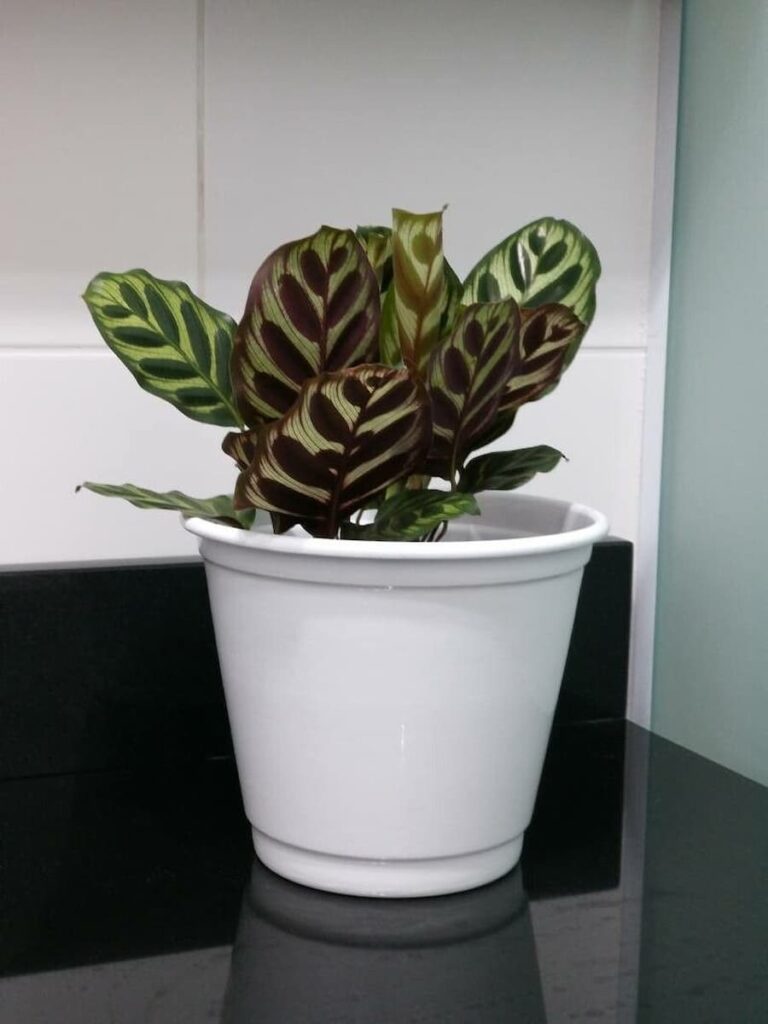
This does mean you will need to insert your finger into the soil to feel how moist or dry it is, but it is the best way to ensure you are properly watering the calathea plant.
Remember, calathea makoyana does not do well in drought conditions, and letting the plant’s soil get too dry for too long can cause its leaves to discolor and drop, and the overall health of the plant will suffer.
On the flip side, however, too much water will increase the chance of the plant getting rot.
How do I know if my Calathea Makoyana needs water?
To ensure you are properly watering the calathea makoyana, insert your finger 2 inches into the plant’s soil. Water if the soil feels dry. If the soil still feels damp, wait another day before checking the soil’s dampness to see if it’s ready for another drink.
If you notice the calathea makoyana is developing brown leaves that feel crispy, then you know the plant is suffering from underwatering.
Other signs that the plant needs to be watered include wilted leaves that may drop off the plant, dry soil, and a slowed growth rate.
If the calathea makoyana is extremely underwatered, you will need to soak the plant in water for about 20 to 30 minutes. This is especially important if you try watering the plant and the water simply rolls off the top of the soil.
Once the plant has soaked for the allotted amount of top, lift it up and out of the water, let the excess water drain out of the pot, and then set the plant back in its area.
Can you water Calathea Makoyana with tap water?
Calathea makoyana does not do well when watered with tap water. This is because this plant is sensitive to the additives that municipalities typically put in tap water, such as chlorine and fluoride. Exposing the plant to tap water can damage its leaves, causing chemical burns to the calathea makoyana.
The best water to use for calathea makoyana is distilled water, although you can also use rain water or filtered water.
If you decide to use tap water anyway, make sure to let the water sit on your counter for at least 24 hours before watering the calathea. This will give the chlorine enough time to dissipate before you use the water to hydrate the calathea.
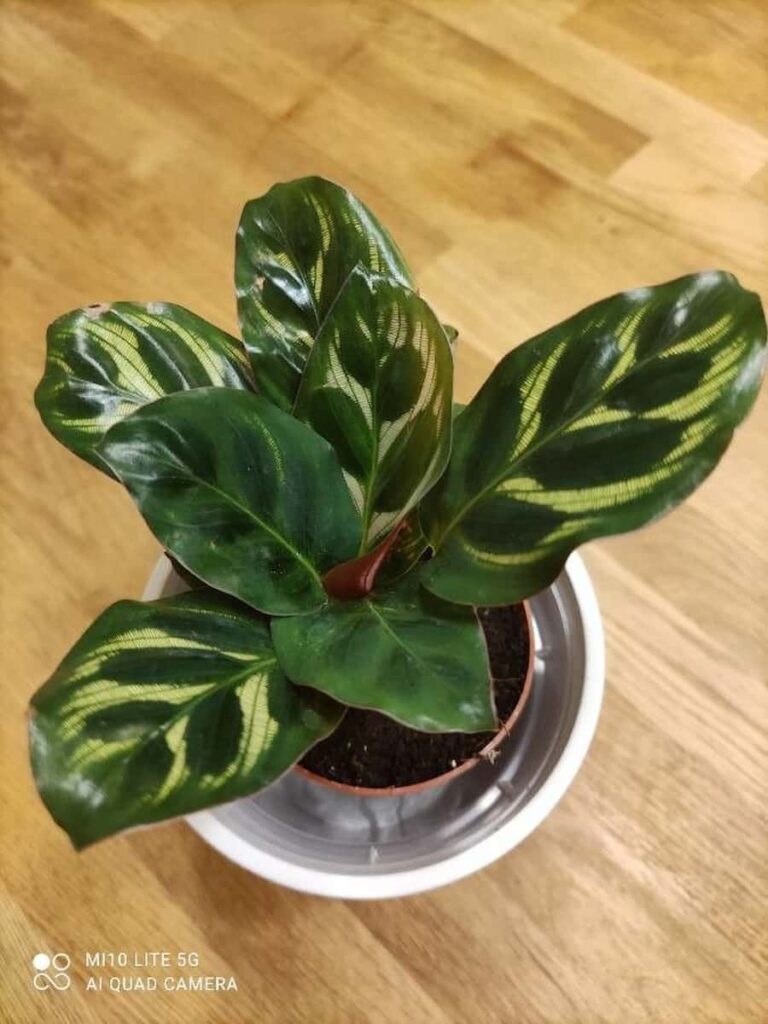
Should I mist Calathea Makoyana every day?
Calathea makoyanas thrive in high humidity levels, and misting it can help achieve those levels that the average home doesn’t typically have. In fact, misting the calathea makoyana every day is a good strategy when your home is experiencing dryer than normal conditions.
Just remember to avoid using tap water when watering or misting your calathea, and instead use distilled water when possible.
Even when misting the calathea, tap water can cause severe damage to the plant’s leaves and overall health. Distilled water doesn’t cause these potential issues.
What are Calathea Makoyana’s light needs?
Calathea makoyana requires bright indirect sun for the best results. While this calathea can tolerate some situations with low light, it is best if it receives 4 to 6 hours of indirect sun every day. If you’re unable to provide sunlight for this amount of time, consider supplementing its lighting needs with artificial lights.
Never expose the calathea makoyana to direct sunlight, as this can not only cause its foliage to dull, but it can also discolor and burn the leaves. This includes sunlight and artificial light as they can both damage the calathea if it is in direct light.
Does Calathea Makoyana need sunlight?
Even though the calathea makoyana can tolerate some low light, it grows best when it receives 4 to 6 hours of indirect sunlight every day. Placing the calathea makoyana in an area void of light will not only cause its growth to stop, but it can actually kill the plant.
This is because, like most other plants, the calathea makoyana needs sunlight to absorb nutrients.
That doesn’t mean, however, that you have to give the calathea actual sunlight. You can use artificial lighting, such as LED bulbs, to supplement natural sunlight.
The calathea makoyana can survive just fine under this type of lighting, as long as the light is not directly shining on the plant.
You may also be interested in: Calathea Light Requirements: The Ultimate Guide
Where should I put Calathea Makoyana indoors?
Your calathea makoyana will grow the best when it is placed in an area with a high humidity level. Bathrooms and kitchens, for example, typically have a higher humidity level than living rooms and will often make the ideal location for this tropical plant.
No matter where you place the plant, however, you should ensure the temperature falls between 65 and 75 degrees at all times.
Another thing to consider when deciding where to grow your calathea makoyana is the areas’ lighting conditions. This plant needs 4 to 6 hours of direct sun for the best growth, and it should be kept away from harsh light.
If the area where you want to grow this plant is in direct sun, you will need to find a different spot with indirect lighting.
How to propagate Calathea Makoyana
Like other calathea varieties, the calathea makoyana is propagated using the division method. This means dividing the plant via its root system to make smaller plants. Depending on how large the calathea is, you could end up with many different smaller plants during the propagation process.
This does mean, however, that you will have to remove the calathea makoyana from its pot and then divide any sections that have their own root system.
Each section that has its own root system will become a new plant and, similar to propagating calathea plants in general, will need to be planted in its own pot.
After you have planted the young plants in their new pots, set the pots in an area that is between 65 and 75 degrees.
They should also be kept out of direct sun, but receive bright indirect light. Mist the plants every day with distilled water until new plant growth appears.
Are Calathea Makoyana high maintenance?
Calathea makoyanas are not high maintenance, per say, but they do require a bit more care than your average houseplant. They need warm temperatures and high humidity levels, which is something that most tropical houseplants need.
Where they differ from other common houseplants, however, is that they need soil that stays damp, but not soggy, and will require daily misting.
That doesn’t mean you should avoid this stunning plant. Even if you’re new to the whole houseplant game, you should still consider giving this calathea variety a chance.
As long as you learn its ideal growing requirements and then strive to achieve that, you will have great success growing this tropical beauty.
How hard is it to keep a Calathea Makoyana alive?
Despite the bit of work you have to put in with the calathea makoyana, they are not too difficult to keep alive. They do require specific temperature, humidity, watering, and lighting needs that you must meet, but if you have ever grown a tropical houseplant before, you should be familiar with these needs.
Even though they get a bad rap sometimes for being a bit fussy, they can tolerate some deviations from their growing requirements. For example, they grow best when they have bright indirect light, but they can tolerate low to medium lighting conditions as well.
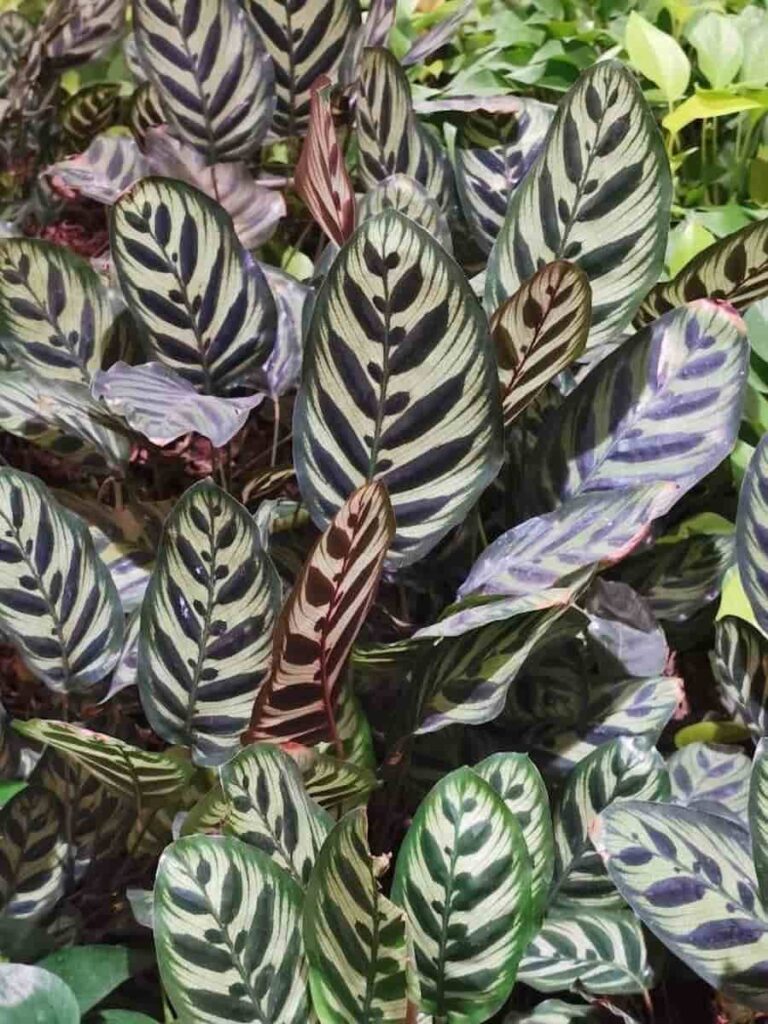
Does Calathea Makoyana flower?
When grown outdoors in its native habitat, the calathea makoyana does produce small white and purple flowers. These blooms are tiny and grown in clusters at the ends of the plant’s stems. Unfortunately, it is rare for this plant to flower when grown indoors as a houseplant.
Even when given its ideal growing conditions, the chances of your calathea makoyana houseplant flowering are slim to none.
That doesn’t mean you shouldn’t grow this plant, however. The calathea makoyana is typically grown for its large, attractive foliage, which is much more noticeable than its tiny blooms.
Is Calathea Makoyana poisonous?
Calathea makoyana is not poisonous and can be safely kept in homes with children, dogs, and cats. That doesn’t mean, however, that you should allow your children or pets to chew or bother this plant. Even if it isn’t toxic, it can still cause gastrointestinal distress, such as vomiting and diarrhea, if consumed.
Additionally, allowing children and pets to chew or play with the calathea makoyana could damage the plant’s leaves and stems.
Once the leaves have been ripped or torn, they will not heal themselves. This can harm the appearance of the calathea makoyana and can even make it more difficult for the plant to absorb nutrients via its leaves.
Why does my Calathea Makoyana have brown tips?
Brown tips on a calathea makoyana are a sure sign that you are watering the plant with tap water. Like other calatheas, the makoyana variety is sensitive to the chemicals, salts, and minerals commonly found in tap water.
The best way to avoid this issue is to water, and mist, the calathea makoyana with distilled water instead.
Alternatively, you can use filtered water and even rain water to hydrate the calathea makoyana. Tap water, however, should be avoided at all costs since it can damage the calathea.
Find out more: 12 Causes of Brown Spots on Calathea (+ How to Fix It)
Why does my Calathea Makoyana have yellow leaves?
When your calathea makoyana has yellow leaves it is usually because the plant is overwatered. This can occur if you are giving the plant too much water or the plant is growing in soil that doesn’t drain properly.
No matter which one is causing the issue, it will need to be addressed as soon as possible.
If you are overwatering the calathea makoyana, stop all watering and misting immediately and wait until the soil dries out before you start watering and misting the plant again.
In addition, if you suspect rot has already started to form, you can try to save the plant by removing it from the pot and getting rid of all the soil.
Examine the roots of the calathea and cut off any that are brown or black, rotted, damaged, or diseased. Repot the calathea makoyana in a sanitized container with fresh soil that is light and airy.
Remember that once root rot has formed, saving the infected plant can be extremely difficult.
Related: 11 Causes of Yellow Leaves on Calathea (+ How to Fix It)
Should I bottom water Calathea Makoyana?
If you want to avoid overwatering the calathea makoyana, consider using the bottom watering method. This involves filling a container or the sink with a few inches of water and submerging the bottom of the calathea’s pot in said water. Wait about 10 minutes before checking to see how damp the soil is.
If the soil still feels dry, let the calathea makoyana soak for another 10 minutes. Continue in this manner, adding additional water to the container or sink as needed, until the plant’s soil feels damp.
Source: Chee Keong Chan (CC BY-SA 4.0)
Once it feels damp, remove the calathea makoyana from the water and set it on its drip tray.
Make sure not to use tap water when watering the calathea makoyana. Even if you are bottom watering the calathea, tap water can still cause the same issues as if you watered the plant in the more traditional method. If possible, use distilled water, followed by filtered or rain water, to hydrate any calathea variety.
How long should you bottom water a Calathea Makoyana for?
The length of time the calathea makoyana is bottom watered varies from one situation to the next. However, in most cases, it will take about 20 to 40 minutes for the plant to be properly watered using the bottom watering method.
Moreover, this can vary from one plant to the other based on its age and size, and the conditions of the room it is growing in.
No matter what, you should always check how dry/moist the soil is every 10 minutes throughout the bottom watering method. This helps prevent making the soil too soggy, while also ensuring you are properly hydrating the plant.
Additionally, you should only use distilled water when bottom watering the calathea makoyana, or any type of watering for that matter. Using tap water will only increase the chance of harming the calathea makoyana. You can also use filtered water or rain water if you don’t have access to distilled water.
